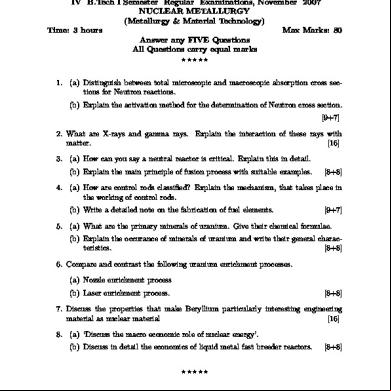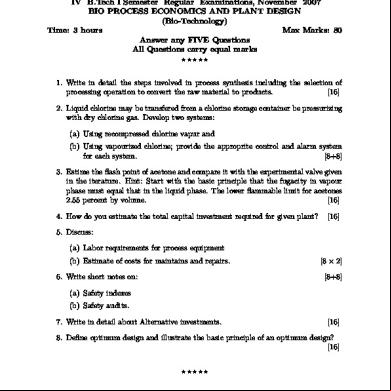Rr411806 Nuclear Metallurgy 4a5g1l
This document was ed by and they confirmed that they have the permission to share it. If you are author or own the copyright of this book, please report to us by using this report form. Report 3b7i
Overview 3e4r5l
& View Rr411806 Nuclear Metallurgy as PDF for free.
More details w3441
- Words: 952
- Pages: 4
Set No. 1
Code No: RR411806
IV B.Tech I Semester Regular Examinations, November 2007 NUCLEAR METALLURGY (Metallurgy & Material Technology) Time: 3 hours Max Marks: 80 Answer any FIVE Questions All Questions carry equal marks ⋆⋆⋆⋆⋆ 1. (a) Distinguish between total microscopic and macroscopic absorption cross sections for Neutron reactions. (b) Explain the activation method for the determination of Neutron cross section. [9+7] 2. What are X-rays and gamma rays. Explain the interaction of these rays with matter. [16] 3. (a) How can you say a neutral reactor is critical. Explain this in detail. (b) Explain the main principle of fusion process with suitable examples.
[8+8]
4. (a) How are control rods classified? Explain the mechanism, that takes place in the working of control rods. (b) Write a detailed note on the fabrication of fuel elements.
[9+7]
5. (a) What are the primary minerals of uranium. Give their chemical formulae. (b) Explain the occurance of minerals of uranium and write their general characteristics. [8+8] 6. Compare and contrast the following uranium enrichment processes. (a) Nozzle enrichment process (b) Laser enrichment process.
[8+8]
7. Discuss the properties that make Beryllium particularly interesting engineering material as nuclear material [16] 8. (a) ‘Discuss the macro economic role of nuclear energy’. (b) Discuss in detail the economics of liquid metal fast breeder reactors. ⋆⋆⋆⋆⋆
1 of 1
[8+8]
Set No. 2
Code No: RR411806
IV B.Tech I Semester Regular Examinations, November 2007 NUCLEAR METALLURGY (Metallurgy & Material Technology) Time: 3 hours Max Marks: 80 Answer any FIVE Questions All Questions carry equal marks ⋆⋆⋆⋆⋆ 1. (a) What are secondary Neutrons. How are they generated? Explain their significance. (b) Write a short notes on the following i. Binding energy of the Nucleus ii. Rest mass
[8+8]
2. (a) Describe the early and delayed somatic effects of radiation. (b) Explain the genetic effects of radiation damage.
[8+8]
3. Classify the nuclear reactors based on the coolants used. Write down-the fuel, and canning material in each category. [16] 4. (a) Explain about the following control rod materials. i. Boron carbide ii. Silver-indium-cium. (b) Explain with examples the use of reflectors in nuclear reactors.
[10+6]
5. (a) Explain why thorium is not directly used for structural purposes. (b) Explain the important applications of thorium. (c) Write down the important thorium bearing minerals and explain them. [6+5+5] 6. (a) Write down the flow sheet and explain for the production of thorium form beach sands. (b) Explain the important properties of thorium. 7. Write an essay on the measures taken to conserve uranium supplies.
[10+6] [16]
8. (a) What are the important properties of plutonium. (b) Explain the recycling scheme for plutonium in a thermal reactor. ⋆⋆⋆⋆⋆
1 of 1
[7+9]
Set No. 3
Code No: RR411806
IV B.Tech I Semester Regular Examinations, November 2007 NUCLEAR METALLURGY (Metallurgy & Material Technology) Time: 3 hours Max Marks: 80 Answer any FIVE Questions All Questions carry equal marks ⋆⋆⋆⋆⋆ 1. (a) Distinguish among the following i. Fast Neutrons ii. Slow Neutrons iii. Thermal Neutrons (b) Explain the following i. Elastic scattering ii. In elastic scattering iii. Radiative capture
[7+9]
2. (a) Explain the effects of radiation on fissile and non-fissile materials. (b) How can one say that a reactor is in critical state? (c) Explain how the detection of radiation takes place.
[6+5+5]
3. How are nuclear reactors classified on the basis neutron energies. Explain any 2 of them in detail. [16] 4. (a) Explain about the following control rod materials. i. Boron carbide ii. Silver-indium-cium. (b) Explain with examples the use of reflectors in nuclear reactors.
[10+6]
5. (a) What are the primary minerals of uranium. Give their chemical formulae. (b) Explain the occurance of minerals of uranium and write their general characteristics. [8+8] 6. What are the various methods available for the enrichment of uranium. Explain any one method in detail. [16] 7. With the help of reactional equation explain how non fissionable thorium is converted into fissionable isotope of uranium. [16] 8. (a) ‘A continuing shortage of fossil fuel would be found to impinge upon the price of uranium’ and thus affecting economics of thermal nuclear power stations’ Explain in detail. (b) Discuss the convertion 238U in to fissile plutonium. ⋆⋆⋆⋆⋆ 1 of 1
[9+7]
Set No. 4
Code No: RR411806
IV B.Tech I Semester Regular Examinations, November 2007 NUCLEAR METALLURGY (Metallurgy & Material Technology) Time: 3 hours Max Marks: 80 Answer any FIVE Questions All Questions carry equal marks ⋆⋆⋆⋆⋆ 1. (a) Calculate in Mev the energy equivalent to one gram atomic weight of electrons at rest. (Mass of 1 electron: 9.1×10−28 gm). (b) Rn222 has a half life period of 3.83 days. What fraction of the sample will remain undecomposed at the end of 10 days? [7+9] 2. Write a detailed on the following (a) thermal cycling (b) protection against radiation. (c) radiation detection.
[5+6+5]
3. (a) Explain with the help of a neat sketch the working principle of boiling-water reactor system. (b) compare the advantages and disadvantages of this over pressurized water reactor system. [8+8] 4. (a) Explain the necessary conditions for criticality in a reactor. (b) Explain how is the heat produced in a nuclear reactor.
[9+7]
5. (a) What is carnotite? Give the chemical formula of it. give the metallic elements present in the mineral. (b) Explain the important physical and metallurgical characteristic properties of plutonium. [8+8] 6. What are the various methods available for the enrichment of uranium. Explain any one method in detail. [16] 7. Write an essay on the measures taken to conserve uranium supplies.
[16]
8. (a) What are the important properties of plutonium. (b) Explain the recycling scheme for plutonium in a thermal reactor. ⋆⋆⋆⋆⋆
1 of 1
[7+9]
Code No: RR411806
IV B.Tech I Semester Regular Examinations, November 2007 NUCLEAR METALLURGY (Metallurgy & Material Technology) Time: 3 hours Max Marks: 80 Answer any FIVE Questions All Questions carry equal marks ⋆⋆⋆⋆⋆ 1. (a) Distinguish between total microscopic and macroscopic absorption cross sections for Neutron reactions. (b) Explain the activation method for the determination of Neutron cross section. [9+7] 2. What are X-rays and gamma rays. Explain the interaction of these rays with matter. [16] 3. (a) How can you say a neutral reactor is critical. Explain this in detail. (b) Explain the main principle of fusion process with suitable examples.
[8+8]
4. (a) How are control rods classified? Explain the mechanism, that takes place in the working of control rods. (b) Write a detailed note on the fabrication of fuel elements.
[9+7]
5. (a) What are the primary minerals of uranium. Give their chemical formulae. (b) Explain the occurance of minerals of uranium and write their general characteristics. [8+8] 6. Compare and contrast the following uranium enrichment processes. (a) Nozzle enrichment process (b) Laser enrichment process.
[8+8]
7. Discuss the properties that make Beryllium particularly interesting engineering material as nuclear material [16] 8. (a) ‘Discuss the macro economic role of nuclear energy’. (b) Discuss in detail the economics of liquid metal fast breeder reactors. ⋆⋆⋆⋆⋆
1 of 1
[8+8]
Set No. 2
Code No: RR411806
IV B.Tech I Semester Regular Examinations, November 2007 NUCLEAR METALLURGY (Metallurgy & Material Technology) Time: 3 hours Max Marks: 80 Answer any FIVE Questions All Questions carry equal marks ⋆⋆⋆⋆⋆ 1. (a) What are secondary Neutrons. How are they generated? Explain their significance. (b) Write a short notes on the following i. Binding energy of the Nucleus ii. Rest mass
[8+8]
2. (a) Describe the early and delayed somatic effects of radiation. (b) Explain the genetic effects of radiation damage.
[8+8]
3. Classify the nuclear reactors based on the coolants used. Write down-the fuel, and canning material in each category. [16] 4. (a) Explain about the following control rod materials. i. Boron carbide ii. Silver-indium-cium. (b) Explain with examples the use of reflectors in nuclear reactors.
[10+6]
5. (a) Explain why thorium is not directly used for structural purposes. (b) Explain the important applications of thorium. (c) Write down the important thorium bearing minerals and explain them. [6+5+5] 6. (a) Write down the flow sheet and explain for the production of thorium form beach sands. (b) Explain the important properties of thorium. 7. Write an essay on the measures taken to conserve uranium supplies.
[10+6] [16]
8. (a) What are the important properties of plutonium. (b) Explain the recycling scheme for plutonium in a thermal reactor. ⋆⋆⋆⋆⋆
1 of 1
[7+9]
Set No. 3
Code No: RR411806
IV B.Tech I Semester Regular Examinations, November 2007 NUCLEAR METALLURGY (Metallurgy & Material Technology) Time: 3 hours Max Marks: 80 Answer any FIVE Questions All Questions carry equal marks ⋆⋆⋆⋆⋆ 1. (a) Distinguish among the following i. Fast Neutrons ii. Slow Neutrons iii. Thermal Neutrons (b) Explain the following i. Elastic scattering ii. In elastic scattering iii. Radiative capture
[7+9]
2. (a) Explain the effects of radiation on fissile and non-fissile materials. (b) How can one say that a reactor is in critical state? (c) Explain how the detection of radiation takes place.
[6+5+5]
3. How are nuclear reactors classified on the basis neutron energies. Explain any 2 of them in detail. [16] 4. (a) Explain about the following control rod materials. i. Boron carbide ii. Silver-indium-cium. (b) Explain with examples the use of reflectors in nuclear reactors.
[10+6]
5. (a) What are the primary minerals of uranium. Give their chemical formulae. (b) Explain the occurance of minerals of uranium and write their general characteristics. [8+8] 6. What are the various methods available for the enrichment of uranium. Explain any one method in detail. [16] 7. With the help of reactional equation explain how non fissionable thorium is converted into fissionable isotope of uranium. [16] 8. (a) ‘A continuing shortage of fossil fuel would be found to impinge upon the price of uranium’ and thus affecting economics of thermal nuclear power stations’ Explain in detail. (b) Discuss the convertion 238U in to fissile plutonium. ⋆⋆⋆⋆⋆ 1 of 1
[9+7]
Set No. 4
Code No: RR411806
IV B.Tech I Semester Regular Examinations, November 2007 NUCLEAR METALLURGY (Metallurgy & Material Technology) Time: 3 hours Max Marks: 80 Answer any FIVE Questions All Questions carry equal marks ⋆⋆⋆⋆⋆ 1. (a) Calculate in Mev the energy equivalent to one gram atomic weight of electrons at rest. (Mass of 1 electron: 9.1×10−28 gm). (b) Rn222 has a half life period of 3.83 days. What fraction of the sample will remain undecomposed at the end of 10 days? [7+9] 2. Write a detailed on the following (a) thermal cycling (b) protection against radiation. (c) radiation detection.
[5+6+5]
3. (a) Explain with the help of a neat sketch the working principle of boiling-water reactor system. (b) compare the advantages and disadvantages of this over pressurized water reactor system. [8+8] 4. (a) Explain the necessary conditions for criticality in a reactor. (b) Explain how is the heat produced in a nuclear reactor.
[9+7]
5. (a) What is carnotite? Give the chemical formula of it. give the metallic elements present in the mineral. (b) Explain the important physical and metallurgical characteristic properties of plutonium. [8+8] 6. What are the various methods available for the enrichment of uranium. Explain any one method in detail. [16] 7. Write an essay on the measures taken to conserve uranium supplies.
[16]
8. (a) What are the important properties of plutonium. (b) Explain the recycling scheme for plutonium in a thermal reactor. ⋆⋆⋆⋆⋆
1 of 1
[7+9]










